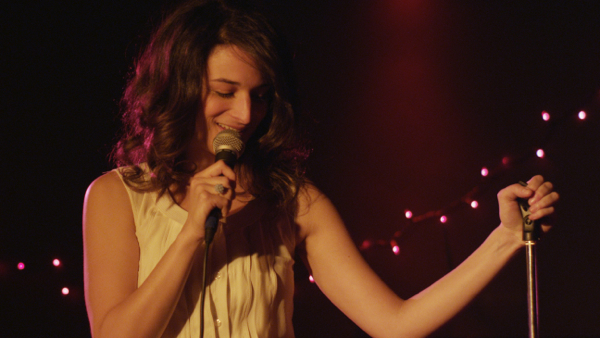Movie review by Greg Carlson
Making her feature debut with an expanded adaptation of her 2009 short, Gillian Robespierre shows plenty of talent and even more promise in “Obvious Child,” a low-budget comedy attracting as much attention for its subject matter as it is for star Jenny Slate’s breakout performance. Slate plays Donna Stern, a smart, underemployed stand-up comic whose candid onstage disclosures drive away an already unfaithful boyfriend. Reeling from the lost relationship, Donna takes refuge in alcohol and an impulsive one-night stand that leads to unexpected fertilization. The plan to terminate the pregnancy is presented as Donna’s straightforward choice – rare in a genre where the full-term outcomes of “Juno” and “Knocked Up” are the standard.
Robespierre has expressed frustration at the way the movie has been labeled online and in print, stating in a “Variety” interview with Brent Lang that “journalists have used the shorthand ‘abortion comedy,’ but that makes it feel small.” Even so, Donna’s decision becomes the motivating issue in the organization of the film’s narrative chronology, climax, and denouement. Abortion has not been entirely foreign to comedies, satires, and comedy-dramas. “The Last American Virgin” (and “Eskimo Limon,” the hugely popular Israeli movie upon which it was based), “Fast Times at Ridgemont High,” “Citizen Ruth,” “Dogma,” and “Palindromes” all dealt to varying degrees with a topic that industry self-censorship organizations had for years discouraged even mentioning.
As explored by Eve Kushner, Lauren Rosewarne, and many others, the most common abortion trope in popular film is not the depiction of a sympathetic protagonist who chooses the procedure. It is instead the firmly established narrative precedent that “Good Girls Avoid Abortion,” the very name bestowed on the convention in the TV Tropes wiki article on the topic. In two separate “Slate” pieces, Roxanne Khamsi and Amanda Hess note the disproportionate number of TV and movie characters who die as a result of choosing abortion. Historically, the overwhelming majority of screen characters who discover an unplanned pregnancy opt against abortion.
Anti-choice viewers will find little to like about Slate’s Donna, whose sense of humor also reveals monumental irreverence about the “human vagina” and its impact on undergarments. The character’s scatological obsession sustains multiple fart and poop jokes. Some gags, like the accidental flatulence that earns one character the nickname “pee farter,” are funnier than others. The screenplay depends on a few contrivances that stretch credulity and would feel more at home in a duller, less imaginative universe. My vote for the worst scene is the revelation that one-night stand Max is a student of Donna’s mother. Max returns a book to her home when Donna happens to be visiting.
Robespierre squeezes every pretty penny out of the licensing fee paid for the Paul Simon song that also gives the movie its title. Featured prominently in the trailer and more than once in the feature itself, “The Obvious Child” underscores one of the best sloppy/goofy underwear dance scenes since Mark Ruffalo and Kirsten Dunst cavorted in “Eternal Sunshine of the Spotless Mind.” While some have speculated on the title song’s meaning in relation to Donna’s pregnancy, the track certainly works as an allusion to the main character’s arrested development and slacker status. No matter what the interpretation, the propulsive, infectious batucada pounded out by Simon’s Bahian collaborators Olodum on the opening tune from “The Rhythm of the Saints” is an inspired selection.
